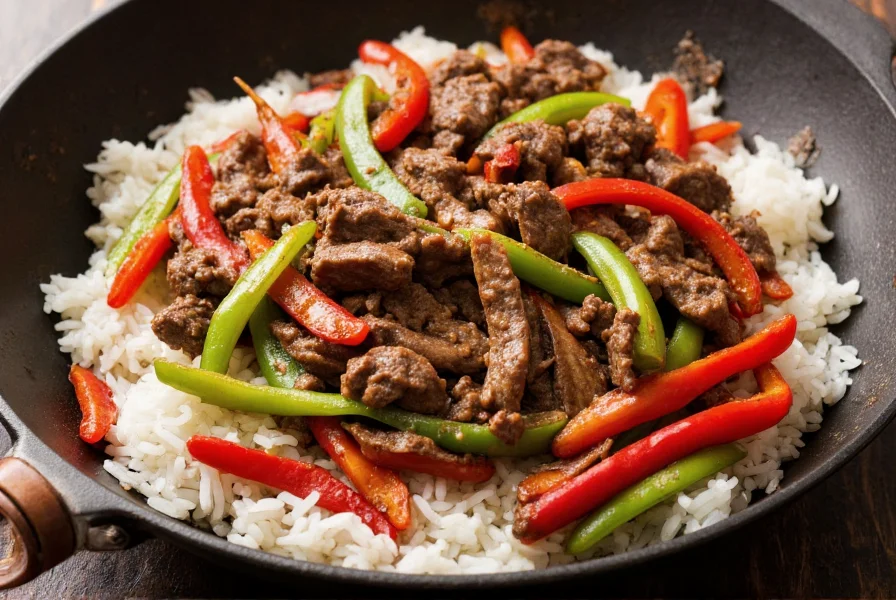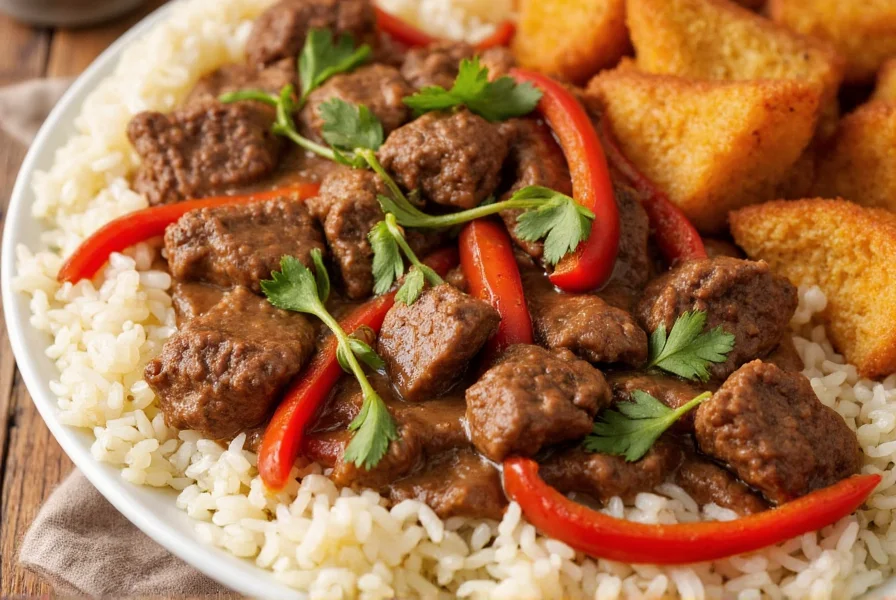Beef pepper steak and rice remains a beloved staple in American-Chinese cuisine, offering a perfect balance of protein, vegetables, and carbohydrates in a single satisfying meal. This dish showcases how simple ingredients transform through proper technique into something extraordinary. The key lies in understanding the interplay between meat preparation, vegetable timing, and sauce composition.
The Origins of Beef Pepper Steak
While often associated with Chinese-American restaurants, beef pepper steak actually represents a fusion creation developed in the United States during the mid-20th century. Chefs adapted traditional Chinese stir-fry techniques using locally available ingredients, resulting in this now-classic combination. Unlike authentic Chinese dishes that might use different cuts or preparation methods, American versions typically feature flank steak and bell peppers for their accessibility and visual appeal.
Essential Ingredients for Authentic Flavor
Selecting quality ingredients makes the difference between an ordinary and exceptional beef pepper steak and rice. The following table outlines precise measurements for a perfect four-serving recipe:
| Ingredient | Measurement | Preparation Notes |
|---|---|---|
| Flank steak | 1.5 lbs | Sliced against the grain into 1/4-inch strips |
| Bell peppers (mixed colors) | 3 medium | Sliced into 1/4-inch strips |
| Yellow onion | 1 large | Sliced into 1/4-inch strips |
| Soy sauce | 3 tbsp | Low sodium preferred |
| Rice vinegar | 1 tbsp | For brightness |
| Garlic | 3 cloves | Minced |
| Ginger | 1 tbsp | Fresh, grated |
| Brown sugar | 1 tbsp | Balances saltiness |
| Sesame oil | 1 tsp | Added at the end |
| Cornstarch | 2 tbsp | For velveting and sauce thickening |
| Long-grain white rice | 1.5 cups | Uncooked |
Professional Technique: Velveting the Beef
Velveting transforms inexpensive flank steak into restaurant-quality tender meat. This Chinese cooking technique involves marinating the beef in a cornstarch slurry before quick frying. For best results:
- Slice the beef against the grain into 1/4-inch strips
- Combine with 1 tbsp soy sauce, 1 tbsp rice vinegar, 1 tbsp cornstarch, and 1 tbsp water
- Let marinate for 15-20 minutes at room temperature
- Quickly blanch in 350°F oil for 60-90 seconds until surface turns opaque
- Remove and drain thoroughly before stir-frying
This process creates a protective coating that seals in juices during high-heat cooking. For home cooks without a deep fryer, substitute with a hot wok and minimal oil—just ensure your pan is properly preheated.
Step-by-Step Cooking Instructions
Follow these precise steps for perfect beef pepper steak and rice every time:
Rice Preparation
Rinse 1.5 cups long-grain white rice under cold water until water runs clear. Combine with 2.25 cups water in a saucepan. Bring to boil, then reduce heat to low, cover, and simmer for 17 minutes. Remove from heat and let stand covered for 10 minutes before fluffing with a fork.
Stir-Fry Process
- Heat 2 tbsp vegetable oil in wok or large skillet over high heat until smoking
- Add marinated beef in single layer; cook 60-90 seconds per side until browned but not fully cooked
- Remove beef and set aside
- Add 1 tbsp oil to wok; stir-fry onions and bell peppers for 2-3 minutes until crisp-tender
- Return beef to wok; add garlic and ginger, stir-frying 30 seconds until fragrant
- Pour in sauce mixture (2 tbsp soy sauce, 1 tbsp rice vinegar, 1 tbsp brown sugar, 1 tbsp cornstarch, 1/4 cup broth or water)
- Cook 1-2 minutes until sauce thickens and coats ingredients
- Remove from heat; stir in 1 tsp sesame oil
Common Mistakes to Avoid
Even experienced cooks make these errors when preparing beef pepper steak and rice:
- Overcrowding the pan - Leads to steaming instead of searing; cook in batches if necessary
- Using cold ingredients - Room temperature meat and vegetables sear properly
- Overcooking the vegetables - They should remain crisp-tender, not mushy
- Adding sauce too early - Sugar in sauce can burn at high temperatures
- Slicing with the grain - Always cut flank steak across the grain for tenderness
Variations for Dietary Preferences
Adapt this classic beef pepper steak and rice recipe to accommodate various dietary needs:
- Gluten-free version: Substitute tamari or coconut aminos for soy sauce
- Low-sodium option: Use reduced-sodium soy sauce and increase ginger/garlic for flavor
- Keto adaptation: Serve over cauliflower rice and increase healthy fats
- Spicy variation: Add 1-2 tsp chili garlic sauce to the sauce mixture
- Vegan alternative: Replace beef with extra-firm tofu and use mushroom broth
Serving Suggestions and Pairings
For a complete meal experience, consider these complementary elements:
- Pair with egg drop soup for a traditional Chinese-American meal progression
- Add a side of steamed broccoli or bok choy for additional vegetables
- Serve with a light, crisp white wine like Riesling or Pinot Grigio
- Garnish with sliced green onions and sesame seeds for visual appeal
- Offer chili oil or hot sauce on the side for those who prefer extra heat

Storage and Reheating Instructions
Proper storage maintains quality for leftovers:
- Cool completely before storing in airtight containers
- Refrigerate for up to 3-4 days
- Freeze for up to 2 months (without rice for best texture)
- Reheat in skillet over medium heat with 1-2 tsp water to restore moisture
- Avoid microwave reheating which makes beef tough and rice gummy
Nutritional Information
Per serving (1/4 of recipe with 1 cup cooked rice):
- Calories: 580
- Protein: 34g
- Carbohydrates: 62g
- Fat: 18g
- Fiber: 3g
- Sodium: 850mg
For a lighter version, reduce rice portion to 1/2 cup and increase vegetable quantity by 50%.

Frequently Asked Questions
What's the best cut of beef for pepper steak?
Flank steak provides the ideal balance of flavor and tenderness when properly sliced against the grain. Sirloin or ribeye work as alternatives but may be more expensive. Avoid tougher cuts like chuck that don't respond well to quick cooking methods.
How can I prevent my beef from becoming tough?
Three key techniques prevent tough beef: 1) Slice against the grain into thin strips, 2) Velvet the beef with cornstarch before cooking, and 3) Cook quickly over high heat without overcooking. Never let the beef sit in the marinade longer than 20 minutes as the cornstarch can break down the texture.
Can I make beef pepper steak ahead of time?
While best served fresh, you can prepare components ahead. Marinate and velvet the beef up to 4 hours in advance. Slice vegetables and make sauce up to 24 hours ahead, storing separately. Cook rice fresh for best texture, but you can prepare it up to 4 hours ahead and reheat with a sprinkle of water.
Why does my sauce separate when I add it to the stir-fry?
Sauce separation typically occurs when the pan isn't hot enough or when adding cold sauce to a hot wok. Ensure your wok is properly preheated before adding sauce. Mix cornstarch thoroughly with cold liquid first, then add to hot ingredients while stirring constantly. The sauce should thicken within 60-90 seconds of adding.
What rice variety works best with beef pepper steak?
Long-grain white rice like jasmine or basmati provides the ideal texture contrast to the stir-fry. These varieties remain fluffy and separate rather than becoming sticky. For authentic Chinese restaurant style, use medium-grain Calrose rice which has a slightly stickier texture that holds sauce well.











 浙公网安备
33010002000092号
浙公网安备
33010002000092号 浙B2-20120091-4
浙B2-20120091-4